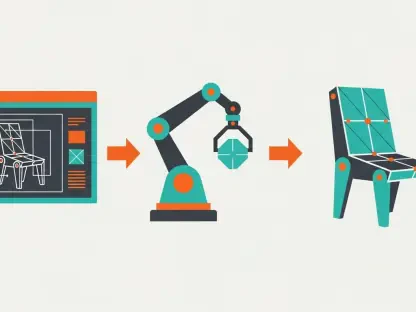In an era where extreme weather events are becoming increasingly frequent and severe, the devastating impact of floods on communities worldwide cannot be overstated, with millions of lives and billions of dollars in infrastructure at risk each year due to inadequate warning systems and unpredictable river discharge patterns. Amid this pressing global challenge, a groundbreaking solution has emerged from the realm of artificial intelligence. This review dives into RiverMamba, an innovative AI architecture designed to revolutionize flood forecasting by delivering precise, scalable predictions even in the most data-scarce regions. By blending cutting-edge technology with environmental science, this model offers a beacon of hope for disaster preparedness and climate adaptation.
Core Features and Technical Innovations
Hybrid Modeling for Enhanced Precision
RiverMamba stands out due to its unique hybrid approach, seamlessly integrating physics-based forecasting methods with advanced deep learning techniques. Unlike traditional models that often require immense computational resources to simulate global flood patterns, this architecture learns from both observational environmental data and outputs of established systems like the Global Flood Awareness System (GloFAS). The result is a balanced framework that achieves high accuracy without sacrificing efficiency, making it feasible to predict flood risks across varied landscapes and climates.
This hybrid methodology allows the model to capture local nuances that global systems might overlook while maintaining the broad scope needed for worldwide applicability. By training on diverse datasets, including precipitation and soil moisture patterns, RiverMamba refines its ability to anticipate river discharge behaviors under different conditions. Such an approach marks a significant leap forward in ensuring that predictions are not only reliable but also actionable for emergency planning.
Adaptability in Challenging Environments
One of the most impressive aspects of RiverMamba is its capacity to operate effectively in regions with limited or incomplete data. Many vulnerable areas, particularly smaller catchment zones, lack the infrastructure for comprehensive monitoring, often rendering traditional forecasting tools ineffective. RiverMamba circumvents this barrier by independently modeling complex interactions between weather dynamics, topography, and runoff processes, delivering robust predictions where others falter.
This adaptability is a critical asset for global flood forecasting, as it ensures that communities in underserved regions are not left behind. The architecture’s design prioritizes flexibility, enabling it to adjust to varying data availability without compromising on the quality of its outputs. This feature positions RiverMamba as an essential tool for equitable disaster risk reduction, addressing disparities in access to early warning systems.
Performance and Real-World Impact
RiverMamba has demonstrated remarkable performance in enhancing the accuracy of flood risk assessments compared to existing methodologies. Its ability to process and analyze environmental patterns with precision allows for earlier and more reliable warnings, a crucial factor in saving lives and minimizing economic losses. In practical deployments, the model has shown promise in supporting early warning systems, particularly in areas prone to sudden heavy rainfall and subsequent flooding.
Beyond technical metrics, the real-world implications of this technology are profound. Vulnerable regions, often the hardest hit by natural disasters, stand to benefit immensely from RiverMamba’s scalable solutions. Whether aiding local governments in planning evacuations or assisting international relief organizations in resource allocation, the architecture proves its worth as a versatile ally in disaster preparedness across diverse geographical contexts.
The scalability of RiverMamba also opens doors to unique applications, such as integration with regional climate adaptation initiatives. By providing detailed insights into potential flood zones, it empowers policymakers to design infrastructure and mitigation strategies tailored to specific risks. This adaptability to varied use cases underscores the model’s potential to transform how societies confront the growing threat of climate-driven catastrophes.
Challenges in Adoption and Implementation
Despite its impressive capabilities, RiverMamba faces several hurdles on the path to widespread adoption. Technical challenges, such as managing data variability across different regions, pose significant obstacles in ensuring consistent performance. In some scenarios, the computational demands of processing large-scale environmental datasets can strain resources, particularly in underfunded areas where such technology is most needed.
Logistical and regulatory barriers further complicate deployment. Integrating RiverMamba with existing forecasting systems requires substantial coordination and standardization, often slowed by bureaucratic processes or incompatible infrastructures. Additionally, ensuring that local authorities are equipped to interpret and act on the model’s outputs remains a critical concern for effective implementation.
Ongoing research efforts are focused on addressing these limitations, with an emphasis on optimizing computational efficiency and enhancing user accessibility. Collaborative initiatives across institutions aim to streamline integration protocols and develop training programs for stakeholders. While these challenges are notable, they do not diminish the transformative potential of RiverMamba but rather highlight areas for continued improvement.
Alignment with Broader AI Trends in Environmental Modeling
RiverMamba reflects a pivotal trend in environmental forecasting toward hybrid systems that combine data-driven AI with traditional scientific approaches. This shift acknowledges the limitations of standalone methodologies, recognizing that neither purely physics-based nor solely AI-driven models can fully tackle the intricacies of global flood prediction. By embodying this integrated philosophy, RiverMamba aligns with the scientific community’s growing consensus on the need for complementary tools.
Interdisciplinary collaboration also plays a central role in the evolution of such technologies. The development of RiverMamba through partnerships among leading research bodies exemplifies how merging expertise from AI, hydrology, and climate science can yield innovative solutions. This collaborative spirit mirrors a broader movement in the field, where joint efforts are increasingly seen as vital to addressing the multifaceted challenges posed by climate change.
Looking at the trajectory from 2025 onward, the emphasis on hybrid models is expected to intensify, with AI continuing to augment established forecasting frameworks. RiverMamba’s position at the forefront of this trend suggests it will serve as a blueprint for future advancements, potentially inspiring similar architectures for other environmental concerns like drought or wildfire prediction. Its alignment with these progressive directions reinforces its relevance in shaping the next era of disaster mitigation technology.
Final Thoughts and Future Directions
Looking back, RiverMamba carved a notable path in flood forecasting by leveraging the power of AI to address critical gaps in prediction accuracy and accessibility. Its hybrid design and adaptability to data-scarce environments marked a turning point in how technology could support disaster preparedness. The real-world impact, though still unfolding, pointed to a future where communities worldwide could better brace for the uncertainties of extreme weather.
Moving forward, the focus should shift to overcoming the technical and logistical barriers that hinder broader adoption. Investment in scalable infrastructure and training programs for local stakeholders could bridge the gap between innovation and implementation. Additionally, expanding research into other environmental modeling domains might unlock new applications for RiverMamba’s architecture, amplifying its contributions to global resilience.
A key consideration for the future lies in fostering international collaboration to standardize integration protocols, ensuring that this technology reaches the regions most in need. By prioritizing accessibility and continuous refinement over the coming years, RiverMamba has the potential to not only redefine flood forecasting but also inspire a wave of AI-driven solutions for pressing climate challenges. The journey ahead calls for concerted efforts to turn this promising tool into a cornerstone of disaster risk reduction.









